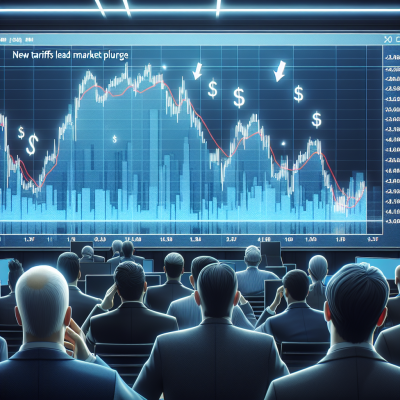
Trump’s New Tariffs Shake Market Confidence
The U.S. economy endured fresh turbulence this week after former President Donald Trump announced a sweeping package of new tariffs targeting the United States’ largest trade partners. In a move that immediately triggered a wave of investor unease, U.S. stock markets fell sharply and the dollar hit a six-month low, raising concerns about the future of global trade and the strength of American exports.
A Familiar Approach with New Consequences
Trump, known for his tough trade stance during his previous term in office, has once again pushed forward with broad tariffs on foreign imports—this time, extending duties beyond China to also include the European Union, Mexico, and Canada. These new tariffs range from 10% to as high as 60% on key goods including steel, electronics, and auto parts.
“We’re going to bring jobs back to America,” Trump declared at a rally announcing the policy, arguing that foreign nations have continued to take advantage of weak trade policies. However, market analysts and economists suggest that the immediate effects of these tariffs may be far from beneficial.
Market Response: Stocks Slide, Dollar Dips
The announcement sparked a massive sell-off across key sectors, including manufacturing, tech, and automotive industries. Major indices such as the S&P 500 and Nasdaq dropped sharply in Thursday’s trading.
Meanwhile, the U.S. dollar slipped to a six-month low against major currencies, including the euro and yen. Currency traders expressed concerns that the tariffs could exacerbate trade tensions, reduce foreign demand for American products, and decrease confidence in the U.S. economy as a whole.
Investor Jitters: What’s Fueling the Market Drop?
Several interwoven factors are contributing to the market downturn:
- Supply chain disruption: The new tariffs increase input costs for manufacturers relying on imported goods, which could lead to squeezed profit margins and higher prices for consumers.
- Retaliatory measures: Countries targeted by the tariffs are expected to introduce countermeasures, potentially igniting a global trade war reminiscent of Trump’s first term.
- Policy uncertainty: Investors dislike unpredictability, and sudden shifts in trade policy can cause long-term hesitation in capital investment and hiring.
How Global Partners Are Reacting
International leaders wasted no time voicing opposition to the new tariffs. The European Commission issued a strongly worded statement, calling the U.S. actions “unilateral and harmful.” Canadian officials hinted at reciprocal measures that would target American agricultural exports, while Mexican representatives warned of economic retaliation that could disrupt the USMCA agreement.
China, a frequent focal point of Trump’s trade wars, has called for ‘restraint’ while warning that it will “take appropriate steps to protect its interests.”
A Flashback to 2018–2019 Trade Wars
Many economists are drawing comparisons to the previous tariff battles during Trump’s first administration. The trade war with China then led to billions in retaliatory tariffs, reduced export volumes, and an eventual hit to American farmers and manufacturers.
“We’ve seen this movie before,” said Lydia Brown, senior economist at Brookings Institution. “What’s different this time is the broader range of countries involved and the already fragile state of global supply chains post-pandemic.”
Economic Uncertainty Ahead of the 2025 Election
Trump’s escalation of trade measures comes amid a heated pre-election climate. With an eye toward regaining the presidency, he’s appealing to the same economic nationalism that energized much of his support in 2016. However, critics argue that focusing on protectionism without addressing root structural problems could backfire both economically and politically.
Consumer prices could rise as companies pass on higher import costs, potentially undermining inflation control efforts by the Federal Reserve and affecting everyday Americans’ cost of living.
Key Sectors to Watch
Industry insiders are keeping a close eye on several vulnerable sectors:
- Automotive companies reliant on imported parts may see dips in productivity and delayed rollouts of new models.
- Technology firms sourcing components from Asia could face increased costs and shipping bottlenecks.
- Agriculture exports might bear the brunt of international retaliatory tariffs, especially in relation to China and Mexico.
What Comes Next?
While the Trump campaign has doubled down on the premise of trade reforms bringing jobs back to the U.S, economic realities suggest a complex path ahead. The pronounced dip in stock values and dollar strength underscores the level of trepidation across financial markets.
Some analysts warn that if left unchecked, the new trade policy regime could put sustained downward pressure on GDP growth and stoke geopolitical tensions at a time when global cooperation is crucial.
In Summary
Trump’s sweeping new tariffs have once again brought trade policy to the forefront of U.S. political and economic discourse. As global markets react and foreign governments prepare countermoves, the ripple effects of these decisions will likely be felt from Wall Street boardrooms to everyday households.
For now, investors and consumers alike are bracing for uncertainty and hoping that cooler diplomatic heads prevail before the fledgling recovery becomes collateral damage in a battle of tariffs and economic nationalism.


Leave a Reply